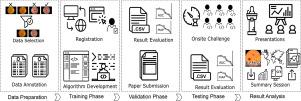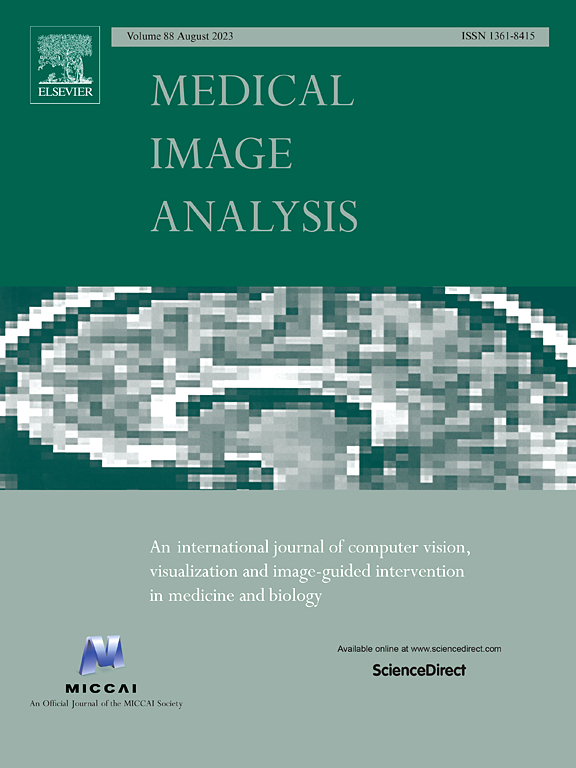RFMiD: Retinal Image Analysis for multi-Disease Detection challenge
IF 11.8
1区 医学
Q1 COMPUTER SCIENCE, ARTIFICIAL INTELLIGENCE
引用次数: 0
Abstract
In the last decades, many publicly available large fundus image datasets have been collected for diabetic retinopathy, glaucoma, and age-related macular degeneration, and a few other frequent pathologies. These publicly available datasets were used to develop a computer-aided disease diagnosis system by training deep learning models to detect these frequent pathologies. One challenge limiting the adoption of a such system by the ophthalmologist is, computer-aided disease diagnosis system ignores sight-threatening rare pathologies such as central retinal artery occlusion or anterior ischemic optic neuropathy and others that ophthalmologists currently detect. Aiming to advance the state-of-the-art in automatic ocular disease classification of frequent diseases along with the rare pathologies, a grand challenge on “Retinal Image Analysis for multi-Disease Detection” was organized in conjunction with the IEEE International Symposium on Biomedical Imaging (ISBI - 2021). This paper, reports the challenge organization, dataset, top-performing participants solutions, evaluation measures, and results based on a new “Retinal Fundus Multi-disease Image Dataset” (RFMiD). There were two principal sub-challenges: disease screening (i.e. presence versus absence of pathology — a binary classification problem) and disease/pathology classification (a 28-class multi-label classification problem). It received a positive response from the scientific community with 74 submissions by individuals/teams that effectively entered in this challenge. The top-performing methodologies utilized a blend of data-preprocessing, data augmentation, pre-trained model, and model ensembling. This multi-disease (frequent and rare pathologies) detection will enable the development of generalizable models for screening the retina, unlike the previous efforts that focused on the detection of specific diseases.

RFMiD:用于多种疾病检测的视网膜图像分析挑战
在过去几十年中,针对糖尿病视网膜病变、青光眼、老年性黄斑变性和其他一些常见病,收集了许多公开的大型眼底图像数据集。这些公开的数据集被用来开发计算机辅助疾病诊断系统,通过训练深度学习模型来检测这些常见病。限制眼科医生采用此类系统的一个挑战是,计算机辅助疾病诊断系统忽略了视网膜中央动脉闭塞或前部缺血性视神经病变等威胁视力的罕见病症,而眼科医生目前检测到的是其他病症。为了推动常见疾病和罕见病的眼科疾病自动分类技术的发展,在电气和电子工程师学会生物医学成像国际研讨会(ISBI - 2021)期间组织了 "用于多种疾病检测的视网膜图像分析 "大型挑战赛。本文报告了基于新的 "视网膜眼底多疾病图像数据集"(RFMiD)的挑战赛组织、数据集、表现最佳的参赛者解决方案、评估措施和结果。其中有两个主要的子挑战:疾病筛查(即是否存在病理--二元分类问题)和疾病/病理分类(28 类多标签分类问题)。挑战赛得到了科学界的积极响应,共有 74 个个人/团队提交了有效的参赛作品。表现最出色的方法综合利用了数据预处理、数据增强、预训练模型和模型组合。这种多疾病(常见病和罕见病)检测方法将有助于开发用于视网膜筛查的通用模型,而不像以前的方法那样只侧重于检测特定疾病。
本文章由计算机程序翻译,如有差异,请以英文原文为准。
求助全文
约1分钟内获得全文
求助全文
来源期刊

Medical image analysis
工程技术-工程:生物医学
CiteScore
22.10
自引率
6.40%
发文量
309
审稿时长
6.6 months
期刊介绍:
Medical Image Analysis serves as a platform for sharing new research findings in the realm of medical and biological image analysis, with a focus on applications of computer vision, virtual reality, and robotics to biomedical imaging challenges. The journal prioritizes the publication of high-quality, original papers contributing to the fundamental science of processing, analyzing, and utilizing medical and biological images. It welcomes approaches utilizing biomedical image datasets across all spatial scales, from molecular/cellular imaging to tissue/organ imaging.
 求助内容:
求助内容: 应助结果提醒方式:
应助结果提醒方式:


